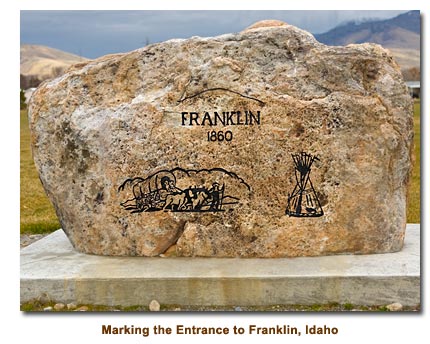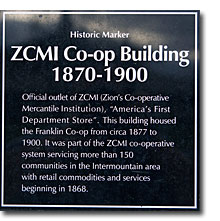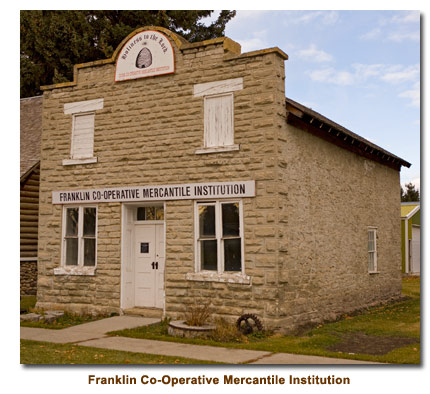Franklin, Idaho— First Settlers
As Cache Valley offered such good opportunities for new home seekers, naturally there was a rapid settlement, especially during the year 1860. In the early spring of this year several groups of settlers near Salt Lake City started for Cache Valley to find new homes and better their conditions. Some were sent by the L.D.S Church, while other came on their own accord. One group consisting of about six families, left Provo in April 1860, and started for Cache Valley. Another group which left in March from Slaterville, and one from Kays Creek a little later, also started for Cache Valley.
One of the parties which arrived at Maughan’s Fort (Wellsville) and rested for a few days, were instructed to proceed north and settle on the east side near the “Muddy River,” now called the Cub River. The party reached a point about two miles southeast of the present townsite of Franklin, and rested in a little cove for three days until a bridge could be built across Spring Creek and a road constructed. In the meantime, their number was increased by other families which joined them. This group, with those from Kays Creek, arrived at the present site of Franklin on the morning of April 14th, 1860, near the east end of Main Street, and were the first settlers to make a permanent settlement in Idaho and the farthermost settlement in the Valley. Their numbers increased rapidly by other emigrants families which joined them, so that by the end of the year there were about sixty families making a substantial settlement.
The following list of men with their families included and early settlers given in alphabetical order, are considered as the founders of Franklin:
| Franklin Settlers | |||
|---|---|---|---|
| Alfred Alader | W. Garner | Peter Lowe | James Packer |
| George Alder | A. Goodliffe | Thomas McCann | Nathan W. Packer |
| E. Broadbent | W. Hull | Joseph Messervy, Jr. | Nephi Packer |
| T. M. Bennett | T. Hull | Joseph Messervy, Sr. | W. Patten |
| W. Comish | Joseph Harris | James May | W. H. Rogers |
| W. K. Comish | W. Harris | G. Mayberry | George Shields |
| John Comish | T. C. D. Howell | John Morrison | John Smith |
| James Cowan, Jr. | Joseph Howell | A. Morrison | Thomas S. Smart |
| James Cowan, Sr. | W. Howell | T. Mendenhall, Jr. | A. Stalker |
| James Chadwick | W. Head | T. Mendenhall, Sr. | James Sanderson |
| W. Corbridge | S. Handy | Edmond Nelson | Preston Thomas |
| G. W. Crocheron | W. Handy | W. G. Nelson | Alma Taylor |
| R. Coultours | LeRoy Holt | J. Oliverson | John Trent |
| J. Doney | M. Hansen | C. Olsen | Isaac H. Vail |
| R. Dowdle | J. Hutching | Samuel R. Parkinson | E. C. Van Orden |
| Joseph Dunkley | E. Kingsford | Shem Purnell | W. T. Wright |
| John Ekins | D. Keell | P. Poole | William Woodward |
| John Foster | W. Lynes | P. Preece | H. Wadman |
| W. Flueitt | James Lofthouse | Joseph Perkins | |
The Indians in the vicinity of Franklin at the time of its settlement were under Chief Kittemare and his band were great beggars and exacted beef, flour, grain, potatoes and other provisions quite frequently. Following the advice of President Brigham Young, their policy was to feed and treat the Indians kindly rather than fight them. Their requests were complied with but at times became very burdensome.
There was a considerable difference between the settlers at Franklin and the parties who visited Idaho before. All the former parties were in the quest of gold or furs or were on expeditions, while the band of pioneers at Franklin came to build up the country, conquer the sage brush wastes and convert them into beautiful homes and farms. They at once began to plough the land and plant their crops and build homes. Being men and women with some years of western experience, they knew that crops could not be grown without the aid of irrigation. A ditch was at once taken out of Maple Creek and the crops irrigated the first season and thus the foundation for the first irrigation system in the state was laid.
Thomas S. Smart was captain and leader of one of the companies to come to Franklin and he, with Samuel R. Prakinson and James Sanderson, formed a committee of three with Alfred Alder as clerk to take charge of the affairs of the colony for the first few months. This committee supervised all the public work, presided at the meetings and looked after the welfare of the settlers.
The log houses were built in the usual fort formation along the sides of a square enclosing a rectangle sixty by ninety rods. The fronts of the houses faced the inside of the square with the corrals and yards and gardens to the rear. On the outside of the fort on the northwest corner a large public corral was built to catch the horses from the range.
June 10th, 1860, President Young of the L.D.S. Church and Governor of the Territory of Utah, organized the ward and appointed Preston Thomas as Bishop. The settlement was named Franklin in honor of Apostle Franklin D. Richards. At this time and for several years Franklin was considered to be in Utah, and all political affairs were conducted under the laws of that Territory.
In 1863, Mr. Lorenzo H. Hatch succeeded Mr. Preston Thomas as Bishop and he occupied this position for several years. Mr. Thomas Lowe was acting bishop for a short time. Mr. Hatch was the first postmaster in 1864, and his annual salary was $24.00.
Whole-hearted cooperation and hard work were no more real or in evidence in any community than in Franklin, and much was accomplished. During the first season they built for themselves homes, planted and harvested crops of grain and vegetables; constructed roads into the canyons so they could get what timber and fire wood they needed; dug a small irrigation canal about three and one-half miles in length with which they irrigated their crops, and erected a log schoolhouse large enough to accommodate all the school children of the settlement.
The season of 1860 was very dry and there was little water in Maple Creek for irrigation. The hay used was the wild grasses in the meadows south and east of the settlement. Very little hay was put up but as the winter was an open one, no cattle starved. The crop acreage was small so that there was sufficient irrigation water. However, an early frost froze the grain and it did not make good flour, and they had poor bread. This year, John Franklin Reed was born, the first child to be born in the settlement.
Soon after the arrival of the settlers, a committee of three was appointed to have the farm and hay lands surrounding the settlement surveyed and distributed. The land and townsite were surveyed by Mr. Jesse W. Fox, a government surveyor. The lots were ten by twenty rods and were allotted to each head of a family. One-acre lots on the bench east of the town, five-acre tracts in the bottoms north, and ten-acre tracts in the meadows south, were assigned. Small tracts of land were used for growing sugar cane and Mr. Thomas Lowe built a wooden roller mill to squeeze the juice from the cane.
The first public building was a log schoolhouse erected in the center of the fort during the summer of 1860. It was used for school, church, amusements and all public gatherings. Mrs. Hannah Comish was the first teacher. George A. Davy and William Woodward were also among the first teachers. The building soon became too small and had to be enlarged. The settlement began to increase rapidly so that in 1865, a rock building was commenced for a meeting house and in 1866 another rock building was built for a schoolhouse. It was a substantial sandstone structure, twenty-five by forty feet, with a shingle roof and ample room for the school children for a number of years. It was finally torn down to make room for the present brick structure. The roof of the meeting house when nearing completion fell in, due to faulty construction. The people were somewhat discouraged and the building was not completed until nine years later. Under the supervision of Mr. T. G. Lowe, the roof was raised and the building completed and it stands today in a good state of preservation and is still used as the meeting house. It, with the rock building at Mendon, are the only two that remain of those early rock buildings in the Valley. The lumber used in these buildings was hauled from the Bear Lake section with ox teams through Emigration Canyon, over a round about road more than fifty miles in length. It was a tremendous undertaking for such a small settlement to commence the construction of two rock buildings such as these at practically the same time.
 Being somewhat removed from Logan and other settlements in the Valley and the terminus for the northern route, naturally home industries were stimulated. In 1861, Joshua Messervy installed a “pit saw” by digging a hole or pit in the ground deep enough so a man could stand in it. The timbers were rolled into position over the pit and with one man in the pit under the log and one on top, with a large saw with handles on each end, the log was slowly ripped into lumber. This was the beginnings of the first lumber industry in Idaho. A little later Samuel R. Parkinson and Thomas Smart built a sawmill operated by an undershot waterwheel near the present residence of S. C. Parkinson. In 1872, Flaven Green built a large sawmill in the canyon at the head of Maple Creek and operated it with steam power and furnished lumber for most of northern Cache Valley.
Being somewhat removed from Logan and other settlements in the Valley and the terminus for the northern route, naturally home industries were stimulated. In 1861, Joshua Messervy installed a “pit saw” by digging a hole or pit in the ground deep enough so a man could stand in it. The timbers were rolled into position over the pit and with one man in the pit under the log and one on top, with a large saw with handles on each end, the log was slowly ripped into lumber. This was the beginnings of the first lumber industry in Idaho. A little later Samuel R. Parkinson and Thomas Smart built a sawmill operated by an undershot waterwheel near the present residence of S. C. Parkinson. In 1872, Flaven Green built a large sawmill in the canyon at the head of Maple Creek and operated it with steam power and furnished lumber for most of northern Cache Valley.
For the first four or five years the settlers had to go to Logan and sometimes as far as Brigham City for their flour. In muddy weather when the roads were not passable and they had no flour, they used boiled wheat with milk. The demand for a gristmill became so urgent that in 1865 Mr. Lorenzo H. Hatch, James Howarth and John Goaslind, who was an expert mechanic, built a gristmill where the present wreck of the gristmill now stands at the northwest part of the town. They had wooden shafts, gearings, cogs and worms. They also used the millstones or burs between which the wheat was ground, and the large undershot wooden water-wheel. This was a great blessing and help to the people. The industry was much appreciated by the people and perhaps the first of its kind to be established in the state.
 For a number of years all the wool was carded at the Hendricks Mill on High Creek at Richmond, but Thomas Lowe and his son T. G. Lowe, on the advice of Edmund Buckley, built a carding mill east of Franklin in 1872, and later it was sold and moved further down the creek where it was reconstructed and converted into a woolen mill called the “North Star Woolen Mills.” It was the pioneer institution of its kind in the state. Mr. Samuel R. Parkinson was the first to open a store in the fall of 1860. However, Thomas Mendenhall sold merchandise in his home prior to that. The mines in Montana offered good opportunities for the settlers to trade and they exported flour, butter, eggs, grain and other supplies. In exchange they received mules, horses, wagons, and other merchandise they needed so badly. Later stores that were established in Franklin were the Franklin Co-operative Mercantile Company, Wevster and Chadwick, and Stalker and Sons.
For a number of years all the wool was carded at the Hendricks Mill on High Creek at Richmond, but Thomas Lowe and his son T. G. Lowe, on the advice of Edmund Buckley, built a carding mill east of Franklin in 1872, and later it was sold and moved further down the creek where it was reconstructed and converted into a woolen mill called the “North Star Woolen Mills.” It was the pioneer institution of its kind in the state. Mr. Samuel R. Parkinson was the first to open a store in the fall of 1860. However, Thomas Mendenhall sold merchandise in his home prior to that. The mines in Montana offered good opportunities for the settlers to trade and they exported flour, butter, eggs, grain and other supplies. In exchange they received mules, horses, wagons, and other merchandise they needed so badly. Later stores that were established in Franklin were the Franklin Co-operative Mercantile Company, Wevster and Chadwick, and Stalker and Sons.
Mr. Thomas Lowe and his son T. G. Lowe, built the first shingle mill in the state, just east of Franklin. The canyons were filled with good timber such as red and white pine, and they made shingles for many of the buildings and homes of the Valley.
